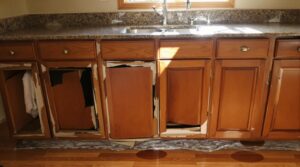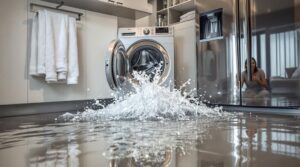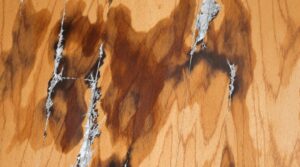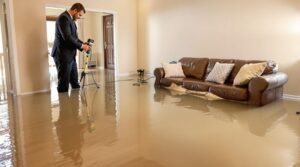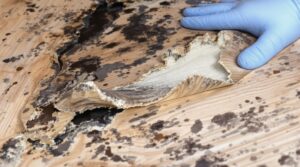Dealing effectively with insurance adjusters after water damage requires thorough documentation before their arrival, including detailed photos, videos, and an inventory of affected items. Property owners should understand their policy coverage, prepare thoroughly for the adjuster's inspection, and implement immediate mitigation measures to prevent further damage. Working with a public adjuster can provide expert guidance, increase settlement amounts, and guarantee proper claim evaluation through advanced detection methods. The following strategies maximize the chances of a successful insurance claim outcome.
Key Takeaways
- Document all water damage thoroughly with dated photos, videos, and detailed notes before the adjuster arrives to establish evidence.
- Prepare a comprehensive inventory of damaged items with descriptions, values, and proof of ownership before meeting the adjuster.
- Accompany the adjuster during inspection, pointing out all damage while taking notes and asking specific questions about coverage.
- Track all expenses related to emergency repairs and temporary mitigation efforts, keeping receipts for insurance reimbursement.
- Consider hiring a public adjuster for complex claims to ensure fair assessment and maximize your settlement potential.
Document Everything Before the Adjuster Arrives
Documentation serves as the foundation for a successful water damage insurance claim. Before the insurance adjuster arrives, homeowners must thoroughly capture evidence of all water-related damages. This includes taking clear, well-lit photographs and videos from multiple angles, ensuring all affected areas are properly documented.
When documenting damages, it's vital to photograph the source of water intrusion, such as burst pipes or roof leaks, and capture timestamped images before any cleanup begins. Photographic evidence should be exhaustive, showing both close-up details and wider views of the damage.
Additionally, creating a detailed inventory of affected items is essential, including descriptions, model numbers, and estimated values. Homeowners should record all initial mitigation efforts, such as emergency repairs or water extraction, and maintain receipts for any expenses incurred.
This documentation should be organized systematically and stored securely, with copies ready for the insurance adjuster's review.
Understanding Your Insurance Policy Coverage

With thorough documentation in place, homeowners must carefully review their insurance policy to understand exactly what types of water damage are covered.
Standard policies typically cover sudden and accidental water damage, while excluding damage from gradual leaks or poor maintenance. Proper policy interpretation is essential, as claim exclusions can notably impact coverage outcomes.
Key aspects of water damage coverage include:
- Sudden plumbing failures and burst pipes are generally covered under basic policies
- Storm-related damage from rain, wind, and hail falls within standard coverage
- Flooding requires separate flood insurance and is not included in standard policies
- Gradual leaks and maintenance-related issues are typically excluded
- Additional riders may be necessary for sewer backup and sump pump failure coverage
Understanding these distinctions helps homeowners navigate the claims process more effectively and anticipate potential coverage limitations before meeting with an insurance adjuster.
This knowledge enables better preparation and more successful claim outcomes.
Meeting With the Insurance Adjuster: What to Expect
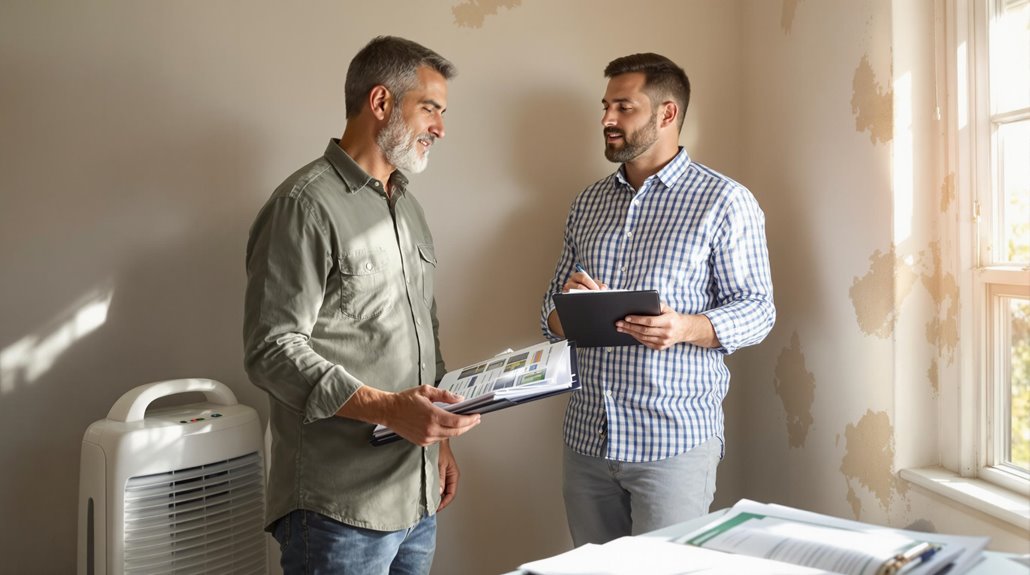
When meeting with an insurance adjuster, homeowners should arrive prepared with thorough documentation including photos, videos, receipts, and contractor estimates to strengthen their position.
Understanding policy rights and coverage limitations enables property owners to effectively advocate for fair compensation during the assessment process.
During the walk-through, clients should methodically point out all damage while taking notes of the adjuster's observations and recommendations, ensuring nothing is overlooked or minimized.
Preparing Essential Documentation Ready
Before meeting with an insurance adjuster, homeowners must gather and organize thorough documentation to support their water damage claim effectively. Document organization plays a vital role in presenting a strong case, while evidence collection guarantees all aspects of the damage are properly recorded.
A well-prepared documentation package demonstrates professionalism and facilitates a smoother claims process.
Essential documentation should include:
- Detailed photographs of all visible water damage and affected areas
- Written timeline of events, including when damage was discovered
- Copies of communication with repair services and contractors
- Complete set of repair estimates and invoices
- Records of all correspondence with the insurance company
Maintaining organized records helps homeowners advocate for their interests while providing adjusters with the necessary information to process claims efficiently and fairly.
Know Your Policy Rights
Building upon a foundation of organized documentation, homeowners must thoroughly understand their insurance policy rights and coverage details to navigate meetings with insurance adjusters successfully.
Understanding policy exclusions and coverage limits enables property owners to advocate effectively for their claims and engage in informed discussions with adjusters.
Homeowners should review their policies carefully to identify which types of water damage are covered, such as sudden pipe bursts or storm-related leaks, versus excluded events like maintenance-related issues or flooding.
Knowledge of specific coverage limits helps set realistic expectations for settlements and supports productive negotiations.
For complex claims, considering the expertise of a public adjuster can provide valuable assistance in understanding policy rights and ensuring fair compensation based on accurate damage assessments.
Walk-Through Best Practices
Successfully maneuvering a walk-through with an insurance adjuster requires thorough preparation and strategic engagement from property owners affected by water damage. During the inspection, property owners should implement effective walk-through strategies and maintain clear adjuster communication to facilitate extensive documentation of all damages.
Property owners must actively participate in the process while maintaining professional demeanor and attention to detail.
- Accompany the adjuster throughout the entire inspection, pointing out all visible and potential hidden damage.
- Document the walk-through with photos, videos, and detailed notes of all observations and discussions.
- Present organized documentation, including pre-existing photos, repair estimates, and inventory lists.
- Ask specific questions about coverage, timeline, and next steps in the claims process.
- Request clarification on any concerning findings or assessments during the inspection.
Protecting Your Property During the Claims Process
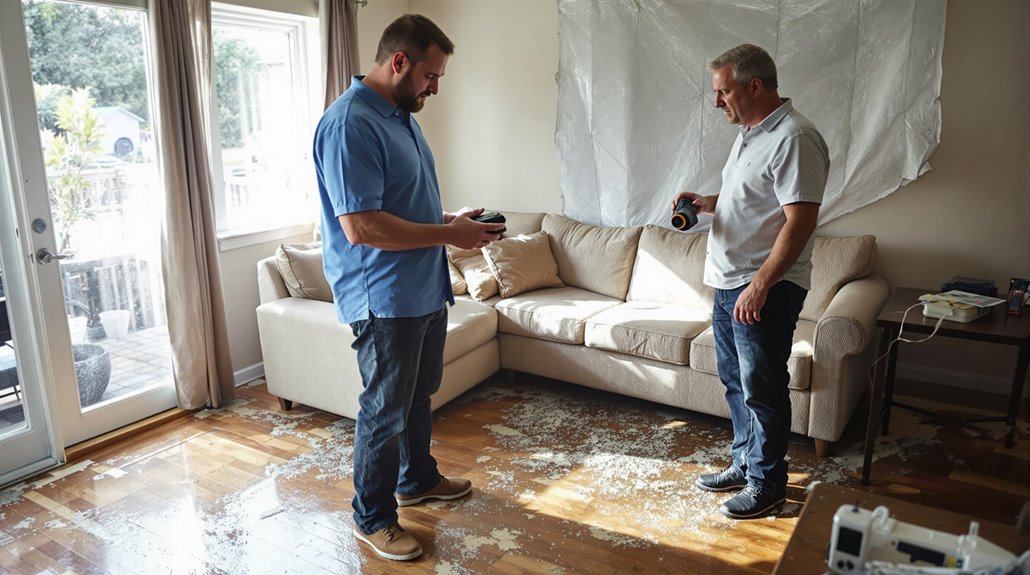
Homeowners must take immediate steps to document and protect their property while managing the insurance claims process after water damage.
Thorough photo and video documentation, along with detailed written records of all damaged items, creates a solid foundation for the claim and helps prevent disputes with adjusters.
Securing damaged areas with tarps or temporary barriers while monitoring moisture levels can prevent further damage and potential mold growth, which could complicate the claims process.
Document Everything Meticulously
Thorough documentation serves as the cornerstone of a successful water damage insurance claim. When conducting damage assessment, homeowners should utilize various documentation tools to create a complete record of the incident. This includes capturing detailed photographs, maintaining organized logs, and preserving evidence of all related expenses.
- Take wide-angle photos showing the full scope of damage, followed by close-up shots of specific problem areas.
- Create a detailed inventory of damaged items, including original purchase prices and replacement costs.
- Record dates, times, and details of all communications with insurance representatives.
- Save all receipts for emergency repairs, temporary housing, and restoration services.
- Maintain a chronological log of events from the initial water damage discovery through the claims process.
Secure Damaged Areas Immediately
While documenting water damage builds a strong foundation for your claim, taking immediate action to secure damaged areas can make the difference between a manageable loss and a catastrophic one. It’s crucial to assess the affected areas promptly and to employ measures such as using fans or dehumidifiers to reduce moisture levels. Be vigilant for signs of water damage on floors, as these can indicate deeper issues that may worsen if left untreated. By addressing the problem quickly, you not only protect your property but also strengthen your case for any necessary insurance claims.
Property owners must prioritize emergency repairs and utility management to prevent further deterioration of the affected areas.
The first step involves shutting off water and electricity to prevent additional damage and safety hazards.
Installing temporary barriers, tarps, or boards over damaged sections helps protect against weather elements and unauthorized access.
Moving salvageable items to dry locations and implementing water extraction measures are essential actions that demonstrate proper mitigation efforts to insurance adjusters.
Professional assistance may be necessary for extensive damage or when specialized equipment is required to secure the premises effectively.
Monitor Moisture and Mold
Effective moisture monitoring stands as a vital defensive strategy during the insurance claims process for water-damaged properties. Utilizing professional moisture detection equipment helps identify hidden water damage and potential problem areas before they escalate into costly repairs.
Early detection and documentation of moisture levels provide significant evidence for insurance claims while enabling swift action for mold prevention.
- Document all moisture readings with photographs and detailed measurements
- Monitor moisture levels in walls, floors, and hidden spaces using specialized meters
- Track changes in moisture content over time to demonstrate drying progress
- Identify potential mold growth areas before they become visible
- Keep detailed records of all moisture-related findings for insurance documentation
These proactive steps help property owners maintain control of their claim while ensuring thorough remediation and preventing future complications.
Negotiating Your Settlement With the Insurance Company
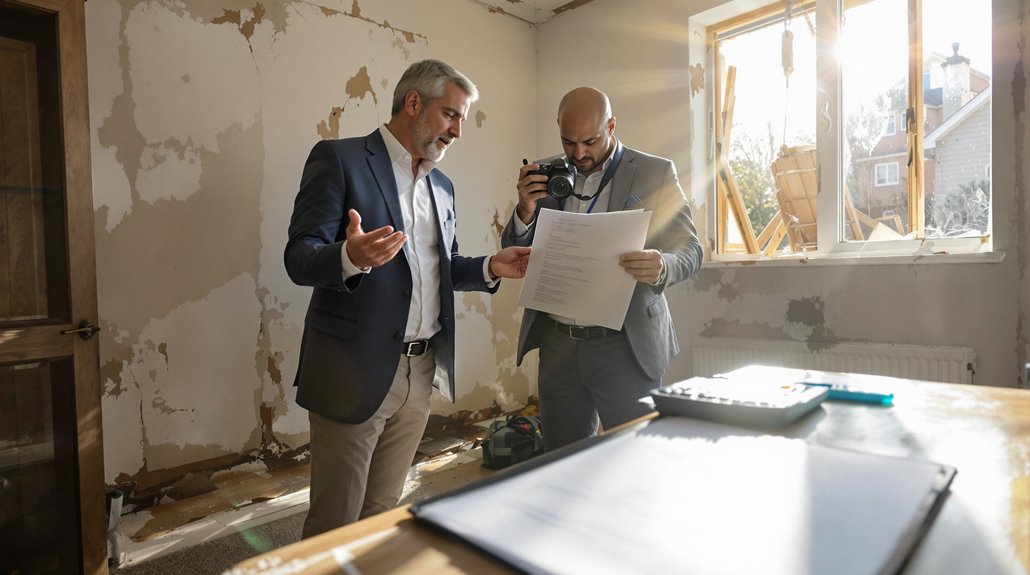
Maneuvering a settlement with an insurance company after water damage requires strategic preparation and unwavering attention to detail. The key to successful settlement negotiation lies in thorough documentation, clear communication, and understanding policyholder rights throughout the claim assessment process.
Property owners should maintain detailed records of all damages, including photographs and written descriptions, while responding promptly to adjuster requests. Understanding the insurance policy's specific coverage and exclusions strengthens the negotiating position.
When evaluating settlement offers, carefully assess whether they adequately cover all repair costs and potential hidden damages. For complex claims, consulting a public adjuster may provide valuable expertise.
Throughout negotiations, maintain professional yet assertive communication with the adjuster, documenting all correspondence. Before accepting any settlement, verify that it addresses all damages and expenses.
If the initial offer proves inadequate, policyholders should be prepared to negotiate further or file complaints with state insurance regulators when necessary.
Working With Public Adjusters and Independent Contractors

After negotiating with insurance companies, many property owners find additional support through public adjusters and independent contractors who specialize in water damage restoration.
Public adjuster benefits include expert guidance in claim negotiations and ensuring accurate damage assessments, while independent contractor responsibilities encompass proper insurance coverage and detailed documentation of all work performed.
Key considerations when working with these professionals include:
- Verifying contractors' insurance coverage through Certificates of Insurance (COI)
- Ensuring contractors maintain both General Liability and Occupational Accident Insurance
- Establishing clear contracts that outline scope of work and insurance requirements
- Maintaining detailed documentation of all damage and restoration efforts
- Facilitating effective communication between all parties involved
When properly managed, the collaboration between property owners, public adjusters, and independent contractors creates a robust approach to water damage claims.
This partnership helps secure fair settlements while ensuring professional restoration work meets required standards and maintains appropriate insurance coverage throughout the process.
The Benefits Of Consulting A Public Adjuster

Public adjusters bring extensive expertise in insurance claims management and provide objective assessments of water damage that maximize potential settlements.
Their professional knowledge of policy terms and documentation requirements helps streamline the complex claims process, saving property owners valuable time and reducing stress.
Through skilled negotiation and thorough documentation practices, public adjusters consistently secure higher claim payouts compared to settlements reached by property owners handling claims independently.
Expertise In Insurance Claims
Leveraging the expertise of a public adjuster can greatly enhance the outcome of water damage insurance claims. Their extensive understanding of insurance policy interpretation and claim negotiation strategies guarantees policyholders receive maximum benefits.
Public adjusters possess deep knowledge of policy language, coverage limits, and exclusions, enabling them to identify all compensable damages effectively.
- In-depth analysis of policy terms and conditions to uncover all available coverage
- Expert documentation of visible and hidden water damage
- Strategic presentation of evidence to support maximum claim value
- Professional negotiation with insurance companies to counter low settlement offers
- Thorough understanding of repair costs and industry standards
Their expertise extends beyond basic claim filing, encompassing detailed damage assessment, proper documentation procedures, and effective communication with insurance carriers.
This professional guidance often results in more favorable claim settlements and faster resolution times.
Objective Damage Assessment
Professional damage assessment through a public adjuster provides property owners with an unbiased and thorough evaluation of water-related losses.
Using advanced water damage detection tools like moisture meters and thermal imaging equipment, public adjusters uncover both visible and hidden damages that might otherwise go unnoticed.
Their extensive assessments include detailed documentation of structural issues, potential mold growth, and other secondary damages caused by water intrusion.
By meticulously photographing and noting all damages, they create a complete record that strengthens the insurance claim.
This systematic approach guarantees that every aspect of the damage is identified, documented, and properly valued.
The resulting assessment serves as a vital foundation for negotiations with insurance companies, helping property owners secure settlements that accurately reflect the full extent of their losses.
Streamlined Claim Process
When property owners face the complex aftermath of water damage, consulting a public adjuster can transform a potentially overwhelming claims process into a streamlined experience.
These professionals enhance claim process efficiency through thorough damage assessment techniques, expert negotiations, and dedicated policyholder advocacy. Their all-encompassing approach guarantees maximum claim potential while minimizing stress for property owners.
- Conducts detailed property inspections to document all visible and hidden water damage
- Handles all communication and paperwork with the insurance company
- Provides expert interpretation of policy terms and conditions
- Creates all-encompassing damage estimates using professional assessment tools
- Negotiates directly with insurance adjusters to secure fair settlements
Public adjusters work on contingency, aligning their interests with the policyholder's success.
Their expertise in local regulations and insurance practices, combined with their commitment to client advocacy, results in more favorable claim outcomes.
Higher Claim Payouts & Settlements
The strategic decision to hire a public adjuster greatly increases the likelihood of securing higher claim payouts and settlements for water damage claims.
Through thorough claim evaluation techniques, including thermal imaging and moisture detection, public adjusters uncover the full extent of damages that might otherwise go unnoticed.
Their expertise in policy interpretation and negotiation tactics proves invaluable when countering insurance company offers.
By meticulously documenting damage, preparing detailed cost estimates, and leveraging their understanding of coverage options, public adjusters maximize settlement potential.
They employ advanced tools and industry knowledge to substantiate claims, while their professional representation guarantees that policyholders' interests remain protected throughout the process.
This expertise, combined with their ability to engage additional specialists when needed, greatly enhances the probability of achieving ideal settlement outcomes.
About The Public Claims Adjusters Network (PCAN)

Public Claims Adjusters Network stands as a thorough claims management organization operating across all 50 states and internationally, specializing in maximizing insurance settlements for property owners facing water damage and other insurance claims.
PCAN services encompass extensive claims advocacy, from initial damage assessment to final settlement negotiations, ensuring policyholders receive fair compensation for their losses.
Through expert policy interpretation and professional representation, PCAN streamlines the entire claims process while protecting clients' interests. Their adjusters handle all communication with insurance companies and manage documentation requirements.
- Expert analysis of insurance policies to identify maximum coverage benefits
- Detailed property damage assessments conducted by experienced professionals
- Complete management of insurance company communications
- Strategic negotiation of settlement terms
- Thorough documentation handling and claim preparation
This client-focused approach allows property owners to focus on recovery while PCAN handles the complexities of their insurance claims, ensuring favorable outcomes through professional advocacy and industry expertise.
Frequently Asked Questions
How Long Does Water Damage Insurance Claim Processing Typically Take?
Water damage insurance claim processing typically takes 1-2 months, encompassing initial inspection, documentation, drying period, estimate settlement, and repairs, though complex cases may extend beyond standard insurance timelines.
Can I Choose My Own Contractor for Water Damage Repairs?
Despite insurance companies pushing their "preferred" contractors like enthusiastic matchmakers, homeowners maintain the right to choose their own contractor and obtain independent repair estimates for water damage restoration work.
Will Filing a Water Damage Claim Increase My Insurance Premiums?
Filing a water damage claim typically impacts premium rates with increases ranging from 7-40%, depending on factors like location, claim history, and the specific type of water damage involved.
What Happens if Mold Develops After the Claim Is Settled?
If mold develops post-settlement, property owners must document and prove its connection to the original claim. Additional compensation for mold remediation may be available if proper post claim responsibilities are fulfilled.
Are Temporary Living Expenses Covered During Water Damage Repairs?
Like a safety net beneath a tightrope walker, homeowners insurance typically covers temporary housing and expense reimbursement during water damage repairs, provided the damage stems from a covered peril.


